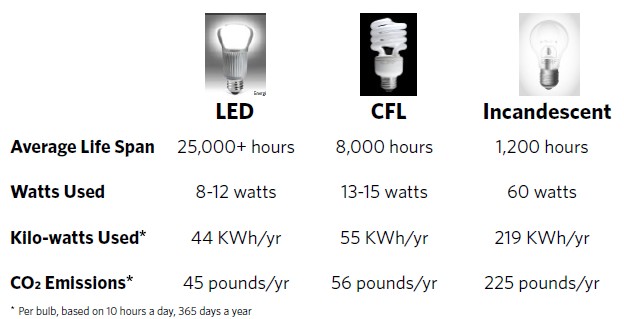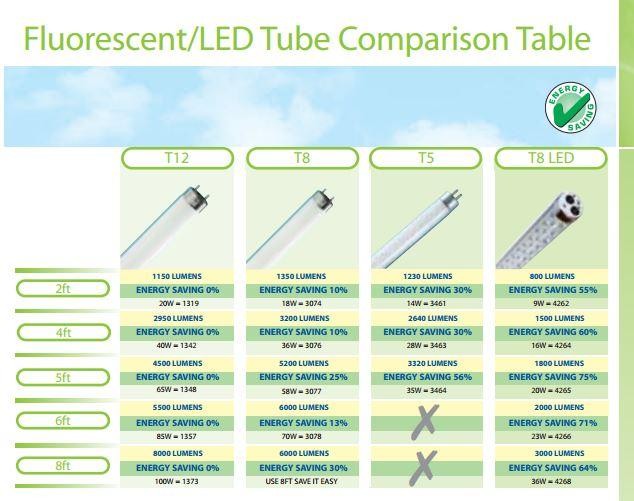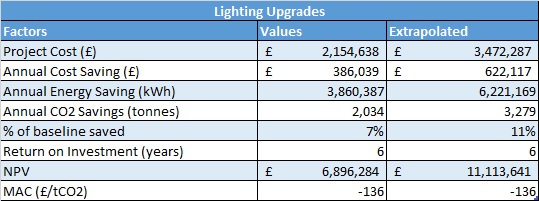Lighting
Savings potential of lighting?
Lighting is a massive contributor to energy usage and, more relevantly carbon emissions on campus. This means that when looking to reduce both energy consumption and carbon emissions the lighting, both internal and external, must be reviewed to determine what sort of savings can be made. A lot will ultimately depend on the initial lighting situation with the most savings being made through replacing older, less efficient lighting such as incandescent lamps whilst whilst lesser savings will be made from replacing newer lamps such as compact fluorescent lamps. The table below is from Boston University which compares these two types of lamps with LED’s to show the various ways in which LED’s are more beneficial for energy efficiency.

This table shows that not only do LED lamps have significantly less carbon emissions per year, they also last a lot longer than incandescents and CFL’s. This longer lifespan could be used in financial calculations to determine savings through reduced maintenance hours.
At the same time as replacing lamps, and based on the results of a detailed lighting analysis, further savings could be made through reducing the number of light fittings within the rooms and corridors. The main determining factors in this would be the lux level resulting from the chosen replacement fittings.
When discussing domestic environments, the Energy Saving Trust states that “you can save money and energy by implementing control mechanisms and being conscious of how you use your lighting.” (Energy Saving Trust, 2014). Given the particular nature of a university campus, there are some differences to domestic environments which complicate this matter, whilst the general principle remains. Where there are multiple different types of room, across multiple buildings all with a very varied schedule of use, it is difficult to implement controls such as set on/off times controlled by a building management system. Because of this issue occupancy sensors and daylight sensors are very appealing as control mechanisms to make lighting usage more appealing. According to the Carbon Trust occupancy sensors can lead to a reduction of up to 30% in electricity use, whilst daylight sensors can lead to as much as a 40% reduction in electricity use (Carbon Trust, 2011).
Strathclyde case study
When looking specifically at lighting within the Strathclyde campus, it was previously mentioned that lighting approximately makes up 25% of the electricity consumption. As a result of this statistic, it was deemed necessary to investigate what potential savings could be made.
The existing lighting database was available for the majority of the buildings on-site, approximately 60% of the campus area, and through analysing that data it was determined that there was a lot of potential to make energy savings through changing to LED lighting. In normal circumstances, in a professional environment, a full lighting survey would have been undertaken with lux levels measured and potentially a reduction made in the number of fittings within each room. Given the constraints inherent in the project it was decided that it would be acceptable to calculate the savings using LED equivalent lamps for the existing fittings. For this a comparison table from Senate was used to identify replacement lamps with approximately equivalent ranges of lumens. A sample of this table is shown below.

In order to account for costs in the project, the specific replacement light fittings were sourced from respectable lighting suppliers such as RS Online and Screwfix which provided costs for the individual lamps. This cost is not entirely accurate as discounts will undoubtedly be given for bulk orders. If retrofitting of fittings is required, additional parts may be required which have at this time not been taken into account. With regards to installation it was estimated that the changing of the lamps would require two technicians, changing on average 4 fittings per hour, and being paid £11 per hour. The results of the calculations have been summarised in the table below.

It can be seen that individually, some of the buildings save less than 1% of baseline CO2 emissions annually, however when all the buildings are totalled together, this equates to around 7%. If this is extrapolated up to 100% of the campus from the 60% mentioned earlier, this reaching 11% of the baseline as shown in the table below.

When reviewing the financial aspect of the lighting alterations, individually a number of buildings would be over the 5 year return on investments, however if they are grouped together, particularly when purchasing the lamps, then the return on investment could come down to around 3.5 years.
As mentioned earlier, these calculations were only performed for an equivalent lighting replacement project so it must be noted that further savings could be made by installing both daylight sensors and occupancy sensors throughout the various rooms on campus.
References
Boston University. (2011) LED Lighting Retrofits. Available at: http://www.bu.edu/sustainability/what-were-doing/energy/led-lighting-retrofits/ (Accessed: 17 April 2016)
Carbon Trust. (2011) Lighting. Available at: http://www.carbontrust.com/resources/guides/energy-efficiency/lighting (Accessed: 17 April 2016)
Energy Saving Trust. (2014) Energy Saving Lamp Comparison Table. Available at: http://www.energysavingtrust.org.uk/domestic/energy-efficient-lighting (Accessed: 17 April 2016)
WF Senate. (2016) Energy Efficient Lighting. Available at: http://www.wfsenate.co.uk/media/uploads/bee51f8f5f304a577cde70e1e37e21db2bf7b60c.pdf (Accessed: 17 April 2016)